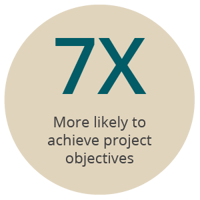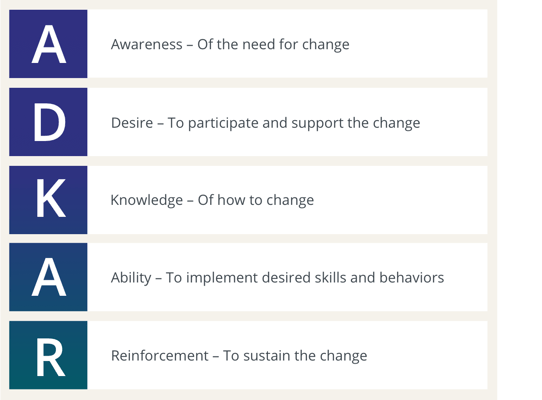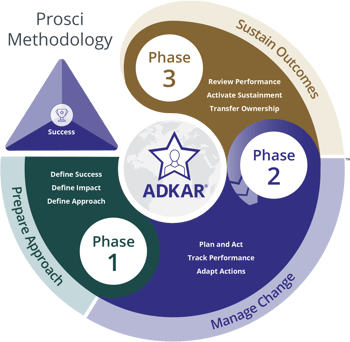Select Your Country
Selecting a different country will redirect you to that homepage.
Singapore
Driving Change success by preparing, equipping and supporting individuals to thrive through change.
Change management as a discipline has evolved and matured over the past quarter of a century. Prosci research tells us that for changes to be successful, we must prepare, equip and support individuals moving through changes so that they successfully adopt the changes. Without adoption, changes will not be successful and we will not deliver the desired outcomes.
Change Management is an enabling framework for managing the people side of change.
Managing change is often simply comprised of a communications plan, where executive leaders or project managers communicate to the organisation that there's change coming (typically on short notice). But change management is much more than communicating what is changing, such as a system implementation or an acquisition.
We must support people in the organisation through their transitions from the current state to the future state, and understand what is needed to influence each person to embrace and adopt the change. In this way, organisations can significantly increase the chances of project success and their project investments paying off.


Organisations adopt the discipline of change management in different ways depending on their business needs. For instance, they have a must-win technology implementation that can benefit from change management, or they decide to invest in change management as an organisational capability to support aggressive business growth. In other words, change management can vary in scope and purpose, and one organisation might define and implement it differently than another.
So it's especially important that companies leverage a structured yet flexible approach to managing change in their organisations.
Change Management at the Project level
The application of the structured process and set of tools for leading the people side of change to achieve a desired outcome on our project.
Change Management at the organisational level
A leadership competency for enabling change within our organisation and a strategic capability designed to increase our change capability and responsiveness.
Whatever change management might look like, the end goal is to help individuals make a change to help the organisation be more successful.
How you manage change impacts the things that matter most to your organisation, including your employees, your customers and your profitability.
Given that organisations are facing faster and more complex changes than ever before, the reasons for change management are only growing. But more than anything, change management prepares, equips and supports employees, so they can engage, adopt and use the change successfully.
The Key Question:
What percentage of overall results and outcomes depends on adoption and usage of the change?
Project management, which focuses on the technical side of change, and change management, which focuses on the people side of change, both play critical roles in change success.
When using a best-practices approach to managing change such implementing a new accounting platform to streamline processes, how much can you improve the likelihood of meeting your project objectives? By a whopping 7X, according to Prosci’s research, where we’ve been surveying practitioners around the globe for more than 25 years:

The costs and risks of mismanaging change by ignoring the people side of change can be significant, impacting not just project outcomes, but timelines, budgets and more.
Prosci’s research consistently shows that organisations with excellent change management achieve greater success with change.



With excellent change management, employees:
Applying the principles of change management before, during and after a project can go a long way in helping you achieve the desired returns on your project investments.

No video selected
Select a video type in the sidebar.
You can increase your organisation’s capacity for change and better prepare for future change by building your overall change capability. We refer to this capability as enterprise change management:
Basically, enterprise change management is the systematic deployment of change management skills, tools and processes throughout an organisation. You can gain these capabilities through avenues such as formally training key roles in your organisation or getting hands-on support from outside experts to build those capabilities internally.
Hear from some of our customers on why their organisations are building change capability.
For a deeper dive into the what and why of change management, view our webinar about the Five Tenets of Change Management.
The Prosci Methodology is one of the most widely used approaches to change management in the world. In fact, Prosci’s offices on numerous continents along with over 30 global partners deliver training and support related to the methodology in every corner of the globe. To date, Prosci has certified more than 100,000 practitioners worldwide.
The Prosci Methodology and its associated models, tools and processes are based on 25+ years of research, making it a true best-practices approach to change management. Let’s take a look at two of the main components of the Prosci Methodology: the Prosci ADKAR Model and the Prosci 3-Phase Process. Both are based on this fundamental principle:
The secret to successful change lies beyond the visible and busy activities that surround change, at its core, is rooted in something much simpler: how to facilitate change with one person.
- Jeff Hiatt, Prosci Founder
.png)
So the question is, how do we facilitate this individual change that leads to organisational change? Most important, we use a structured process—the ADKAR Model—to guide individuals through a particular change to ensure that they embrace and adopt the change.


Practitioners, change sponsors, people managers and others are all involved in this process. By joining forces to apply the ADKAR Model, we can support people in their Awareness about why we’re making the change, which helps foster their Desire to make the change. We provide them Knowledge on how to change and ensure they have the Ability they need to make the change. And we offer Reinforcement to make sure the change sticks.
Thousands of organisations today leverage the ADKAR Model to take on their toughest change challenges. You can learn more about the ADKAR Model in our webinar, ADKAR: The Five Building Blocks of Individual Change.
While the ADKAR Model enables successful change at the individual level, the Prosci 3-Phase Process provides a framework for achieving change at the organisational level. This structured yet flexible process guides practitioners through performing the steps and activities needed to achieve success on a project or initiative. Practitioners apply components of the Prosci Methodology, such as the ADKAR Model and PCT Model, within the framework of the Prosci 3-Phase Process.
Here’s the basic structure of the Prosci 3-Phase Process and the goals of each phase:

Phase 1 – Prepare Approach: To position the change for success by developing a customised and scaled change management strategy with the necessary sponsorship and commitment.
Phase 2 – Manage Change: To achieve adoption and usage of the change by creating, implementing and adapting plan(s) that will move individuals and the organisation through ADKAR transitions.
Phase 3 – Sustain Outcomes: To realise the value of the change by ensuring the change is adopted and the organisation is committed and prepared to sustain the change.
Now that you have a basic understanding about what change management is, why it’s important, and what a proven process for applying it looks like, we have many other resources available to help you gain a deeper understanding of change management and how it can help you and your organisation succeed at change. For additional details about the ADKAR Model and Prosci 3-Phase Process, see the Methodology section of our website.

Stay up to date with the latest blogs, webinars and training opportunities.
You may unsubscribe from our emails at any time. See our privacy policy for more information.
